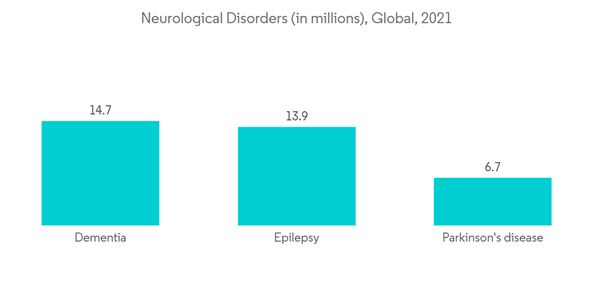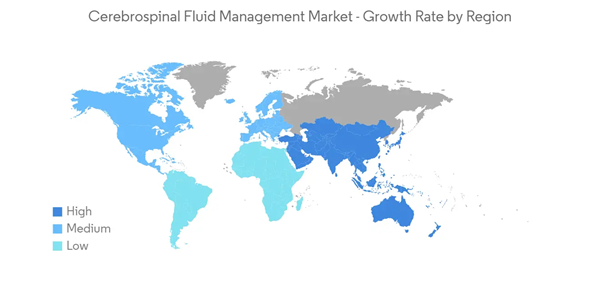The cerebrospinal fluid management market is expected to register a CAGR of 4.4% over the forecast period.
This product will be delivered within 2 business days.
Key Highlights
- COVID-19 had a profound impact on the cerebrospinal fluid management market owing to the cancellations in elective procedures, including treatment and diagnosis of neurological disorders worldwide, impacting the studied market. For instance, according to a World Health Organization (WHO) survey that 155 countries completed over three weeks in May 2020, more than half of the countries surveyed had services for noncommunicable diseases and emergencies, such as various neurological disorders, partially or entirely disrupted. However, the market has been recovering since restrictions were lifted, and government and healthcare organizations put efforts to clear the backlog of treatments caused by the pandemic.
- In addition, the increasing burden of hydrocephalus and other neurological disorders and growing adoption of minimally invasive solutions, and the rising geriatric population are actively affecting the growth of the studied market.
- According to an article published in StatPearls in July 2022, the overall global prevalence of hydrocephalus is roughly 85 per 100,000 individuals, with a significant difference between different age groups. It also stated that the global prevalence is 88 per 100,000 individuals for the pediatric population and 11 per 100,000 individuals for adults.
- According to the same source, due to the high occurrence of normal pressure hydrocephalus (NPH) later in life, the prevalence of hydrocephalus in the elderly population is substantially greater, around 175 per 100,000 people, and more than 400 per 100,000 people for those over 80 years old. The same source reported that Africa and South America have higher hydrocephalus prevalence. Thus, the high prevalence of hydrocephalus worldwide is estimated to propel the market growth during the forecast period.
- Also, as per the article published by the national library of medicine in September 2021, the pooled incidence of congenital hydrocephalus was highest in Africa and Latin America (145 and 316 per 100,000 births, respectively) and lowest in the United States/Canada (68 per 100,000 births). Thus, the high burden of hydrocephalus worldwide is driving the market growth.
- Product launches by key players worldwide are projected to fuel market growth. For instance, in December 2021, Boston-based CereVasc launched the eShunt as the first minimally invasive cerebrospinal fluid shunt. It aims to replace the need for invasive surgery and prolonged hospitalization that come with the current surgical treatment of hydrocephalus. The product launches are estimated to propel the market growth.
- However, a lack of awareness and the dearth of skilled professionals are anticipated to hinder market growth.
Cerebrospinal Fluid Management Market Trends
Adjustable Valve Shunts are Expected to Have Significant Market Growth Over the Forecast Period.
- Adjustable valve shunts are widely used due to the rising incidence of congenital abnormalities, brain and nerve injuries, and accidents leading to central nervous system (CNS) defects.
- The World Health Organization (WHO) estimates that 55 million individuals worldwide currently have dementia, with over 60% of those people residing in low- and middle-income nations. The number of people living with dementia is predicted to increase to 78 million by 2030, and 139 million by 2050 as the proportion of older people in the population rises in almost every nation. Normal pressure hydrocephalus is one of the few causes of dementia. Hence, the high burden of dementia is expected to boost the demand for adjustable valve shunt treatment.
- Furthermore, according to the Hydrocephalus Foundation 2022 update, over 36,000 shunt surgeries are performed every year (one every 15 minutes) in the United States, and more than half of them are emergencies. The high utility of shunts is estimated to boost the demand for adjustable shunts during the forecast period.
- The strategic initiatives like product launches, approvals, and partnerships adopted by key players further propel the segment's growth. For instance, in May 2020, Aesculap, Inc. launched the M.blue valve in partnership with Christoph Miethke GmbH & Co. KG (MIETHKE). It is the latest generation of hydrocephalus valve technology and a simple position-dependent solution. Such launches are estimated to propel the segment's growth during the forecast period.
North America is Anticipated to Hold a Significant Market Share Over the Forecast Period.
- North America is anticipated to grow significantly owing to the well-established healthcare infrastructure, growing awareness regarding the available options for the treatment of hydrocephalus, and high R&D spending.
- According to Hydrocephalus Association 2020 update, hydrocephalus is a life-threatening condition that affects approximately 1 million Americans. It also reported that one out of every 770 babies develops hydrocephalus once in their lifetime. The burden of hydrocephalus in the nation is estimated to boost the market growth.
- Additionally, the strategic initiatives taken by healthcare institutions, such as collaborations and research projects for cerebrospinal fluid management, drive market growth. For instance, in August 2021, the National Institute of Neurological Disorders and Stroke (NINDS) granted USD 14 million to researchers at the Johns Hopkins Cerebral Fluid Center in the Department of Neurosurgery. The research is being conducted in partnership with the Adult Hydrocephalus Clinical Research Network (AHCRN) and coordinated by the Hydrocephalus Association, a non-profit organization that supports hydrocephalus research. The research aims to develop effective treatment options and study the effectiveness of shunts in treatment. These initiatives are estimated to create an opportunity for effective shunt development and boost the utility of shunts for managing the condition, propelling the market growth.
- Similarly, the increase in neurological disorders is fueling market expansion. For instance, according to CDC's April 2022 update, more than 795,000 people in the United States experience a stroke every year. About 610,000 of these are first or new strokes. Thus, the high prevalence of neurological conditions like strokes is estimated to propel the market growth in the forecast period.
- Furthermore, the increasing research and development spending on hydrocephalus in the United States is projected to create opportunities for product development and boost the market growth. For instance, according to the NIH, R&D expenditures for hydrocephalus were USD 15 million in 2020, USD 16 million in 2021, and USD 17 million in 2022, respectively. The increasing spending is estimated to propel market growth in the region during the forecast period.
Cerebrospinal Fluid Management Market Competitor Analysis
The cerebrospinal fluid management market is slightly fragmented due to the presence of many companies operating globally and regionally. The competitive landscape includes an analysis of a few international and local companies with major or significant market shares that are well known. Some key players are Medtronic Plc, B. Braun Melsungen AG, Integra Lifesciences (Arkis BioSciences), Natus Medical Incorporated, Sophysa, Spiegelberg GmbH & Co. KG Moeller Medica, and G.SURGIWEAR LTD, Argi Group, and Aesculap AG.Additional benefits of purchasing the report:
- The market estimate (ME) sheet in Excel format
- 3 months of analyst support
This product will be delivered within 2 business days.
Table of Contents
1 INTRODUCTION
4 MARKET DYNAMICS
5 MARKET SEGMENTATION (Market Size by Value - USD Million)
6 COMPETITIVE LANDSCAPE
Companies Mentioned (Partial List)
A selection of companies mentioned in this report includes, but is not limited to:
- Medtronic Plc
- B. Braun Melsungen AG
- Integra Lifesciences (Arkis BioSciences)
- Natus Medical Incorporated
- Sophysa
- Aesculap AG
- Spiegelberg GmbH & Co. KG
- Moeller Medica
- Argi Group
- G.SURGIWEAR LTD
Methodology

LOADING...










